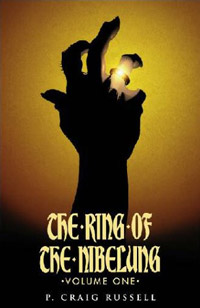By P. Craig Russell
 Russell is one of the comic world’s geniuses
of illustration, and this is his masterpiece. It is truly a labor of
love, a sweeping, two-volume epic that attempts a faithful and musical
interpretation of Wagner’s classic mythological opera.
Russell is one of the comic world’s geniuses
of illustration, and this is his masterpiece. It is truly a labor of
love, a sweeping, two-volume epic that attempts a faithful and musical
interpretation of Wagner’s classic mythological opera.
Though the book is accurately translated, richly scripted, and magnificently
colored, the highlight is clearly Russell’s linework. Combining
stark layout choices with detailed Art Noveau flourishes, Russell succeeds
in creating intense drama. As he explains in a foreword illuminating
his artistic process (which should have been an afterward), he tried
hard to make the artwork musical. Russell can achieve this better than
perhaps any other comic artist. His artwork flows musically, and he renders
much of the text to reinforce musical themes and repeating motifs. The
environment, with its deep streams, dark caverns, high cliffs, broad
forests, and especially the stormy atmosphere, becomes a melodic character
in itself. Sweeping gusts of wind push the Valkyries into flight or steer
Siegfried’s ship swiftly through the sea. Trees loom and drip over
scared heroines and hide devious trolls. Each page would hold its own
against the best Mucha or Parish.
Russell also excels in his draftsmanship of the figure, and manages
to juggle a vast cast with ease. His characters look distinct, showing
a range of emotions whether squeezed into a two-inch panel or sketched
in a beautiful full-page close-up. His women are gorgeous, especially
the three mermaids, and his men are strong and heroic.
So what is the drawback to the book? It’s the source material.
Fans of Wagner will hopefully love the book, and fantasy or mythology
buffs will appreciate its themes, but it is dense and confusing. Several
plot points don’t make much sense, nor does some dialogue. It spans
several generations, and some of the characters seem repetitive and unlikable.
But it’s still far away the best comic adaptation of any opera,
and shows that sequential art does a better job of portraying music and
operatic themes than is possible in other media. Prose can’t include
the music, and film necessarily abbreviates the story. Ideally this work
functions as a link between two seemingly disparate creative forms – introducing
comic book fans to opera and vice versa, bridging “low” and “high” art.